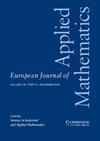马尔可夫时间网络中并发性对流行病传播的影响
IF 1.1
4区 数学
Q1 MATHEMATICS, APPLIED
引用次数: 0
摘要
在给定时间点上共享一个公共节点的边的数量可以量化边的并发性,这可能是时间网络中流行过程的重要决定因素。我们提出了理论上可处理的马尔可夫时间网络模型,其中每条边在连续时间内在活动状态和非活动状态之间翻转。不同的模型具有不同的并发量,而我们可以调整模型以共享相同的边缘激活和停用统计数据(因此每个边缘处于活动状态的时间比例)和聚合(即静态)网络的结构。我们分析地计算每个模型共享一个节点的边的并发量。然后,我们在提出的时间网络模型上数值研究了在随机易感-感染-易感和易感-感染-恢复动力学中并发性对流行病传播的影响。我们发现并发性增强了流行病在流行阈值附近的传播,但在许多情况下这种影响很小。此外,当感染率大大大于流行阈值时,并发性在大多数情况下抑制了流行病的传播。总之,我们的数值模拟表明,在我们的模型中,并发性对增强流行病传播的影响一直存在于流行病阈值附近,但幅度不大。所提出的时间网络模型有望用于研究并发性对网络中各种集体动态的影响,包括感染动态和其他动态。本文章由计算机程序翻译,如有差异,请以英文原文为准。
Effects of concurrency on epidemic spreading in Markovian temporal networks
Abstract The concurrency of edges, quantified by the number of edges that share a common node at a given time point, may be an important determinant of epidemic processes in temporal networks. We propose theoretically tractable Markovian temporal network models in which each edge flips between the active and inactive states in continuous time. The different models have different amounts of concurrency while we can tune the models to share the same statistics of edge activation and deactivation (and hence the fraction of time for which each edge is active) and the structure of the aggregate (i.e., static) network. We analytically calculate the amount of concurrency of edges sharing a node for each model. We then numerically study effects of concurrency on epidemic spreading in the stochastic susceptible-infectious-susceptible and susceptible-infectious-recovered dynamics on the proposed temporal network models. We find that the concurrency enhances epidemic spreading near the epidemic threshold, while this effect is small in many cases. Furthermore, when the infection rate is substantially larger than the epidemic threshold, the concurrency suppresses epidemic spreading in a majority of cases. In sum, our numerical simulations suggest that the impact of concurrency on enhancing epidemic spreading within our model is consistently present near the epidemic threshold but modest. The proposed temporal network models are expected to be useful for investigating effects of concurrency on various collective dynamics on networks including both infectious and other dynamics.
求助全文
通过发布文献求助,成功后即可免费获取论文全文。
去求助
来源期刊
CiteScore
4.70
自引率
0.00%
发文量
31
审稿时长
>12 weeks
期刊介绍:
Since 2008 EJAM surveys have been expanded to cover Applied and Industrial Mathematics. Coverage of the journal has been strengthened in probabilistic applications, while still focusing on those areas of applied mathematics inspired by real-world applications, and at the same time fostering the development of theoretical methods with a broad range of applicability. Survey papers contain reviews of emerging areas of mathematics, either in core areas or with relevance to users in industry and other disciplines. Research papers may be in any area of applied mathematics, with special emphasis on new mathematical ideas, relevant to modelling and analysis in modern science and technology, and the development of interesting mathematical methods of wide applicability.

 求助内容:
求助内容: 应助结果提醒方式:
应助结果提醒方式:


